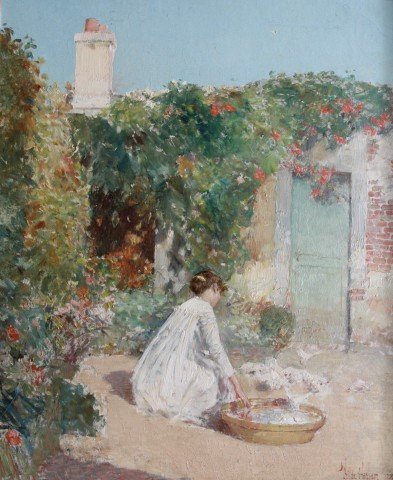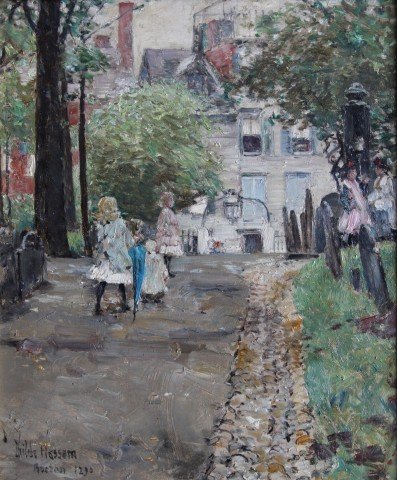Childe Hassam, a pioneer of the American Impressionist style, had a long and very prolific career. By the time of his death in 1935, many critics and artists considered him one of the most significant and influential American painters. His friend and colleague, Boston artist Edmund Charles Tarbell (1862-1938), claimed that Hassam was "one of the great painters of America."(1) Born Frederick Childe Hassam (he later stopped using his first name) on October 17, 1859, he grew up in Dorchester, Massachusetts, then a suburb of Boston. He had a notable artistic and literary lineage and counted both William Morris Hunt (1824-1879) and Nathaniel Hawthorne (1804-1864) among his relatives. At an early age, he developed an interest in drawing and took his first drawing classes in grade school.
Hassam began his artistic career as a commercial illustrator and a watercolorist in Boston, but soon thereafter he enrolled in drawing and painting classes at the Lowell Institute, a school of practical design, and life classes at the Boston Art Club. In 1883 Hassam, accompanied by the illustrator Edmund H. Garrett (1853-1929), traveled to Europe for the first time. During this trip, he studied art in galleries and museums in Great Britain, Holland, Spain, and Italy, and painted numerous watercolors that he exhibited upon his return at the Williams & Everett Gallery in Boston. After some early success as an artist and his marriage to [Kathleen] Maud Doane in 1884, Hassam decided to go to Paris to finish his artistic training. In the fall of 1886, he enrolled at the Académie Julian where, like many other American artists of this period, he pursued the study of figure drawing and exhibited at the Salon. Complaining that the Académie Julian's routine did not permit originality, he left in the spring of 1888. His departure from formal training resulted in a dramatic increase in his output. Hassam remained in Paris until late October of 1889 when he returned to Boston for a brief period before moving to Manhattan.
Hassam quickly became active in the flourishing art world in New York. In 1890, he helped found the New York Water Color Club, joined the American Water Color Society, and was elected to two social and exhibiting organizations for progressive artists, the Players Club and the Society of American Artists. In 1897, he participated in the establishment of the Ten American Painters, an exhibiting society that included William Merritt Chase (1849-1916), Edmund Charles Tarbell, John Twachtman (1853-1902), and Julian Alden Weir (1852-1919). As H. Barbara Weinberg, the Alice Pratt Brown Curator of American Paintings and Sculpture at the Metropolitan Museum of Art, explains, "his involvement in these and other groups was crucial, as they abetted his lifelong campaign to show and sell his works through regular exhibitions" in New York and throughout the United States.(2)
From 1890 to 1919, Hassam and his wife spent almost every winter in Manhattan and nearly every summer in New England. Prior to 1914, they went to Appledore Island in the Isles of Shoals, off the coast of New Hampshire, and often combined their visit there with a brief stay in Gloucester, Massachusetts. After the turn of the century, they began to visit picturesque, historically significant towns with artist colonies in Connecticut, including Cos Cob, Greenwich, and Old Lyme. In 1919, they purchased a house in East Hampton, Long Island, and settled there in the summer months. During these summers, Hassam was very productive, and he returned to New York with a large group of pictures ready for sale. In addition to these excursions, he made five extended visits to Europe. Throughout his career, his travels provided opportunities for him to exchange ideas with other painters and to familiarize himself with the latest trends in art.
Since Hassam rarely worked on commission, he ostensibly had the freedom to paint what he wished. He created intimate interior and exterior images of people laboring or engaging in a leisure activity, and he represented panoramic city or country views in which figures appear small in scale or not at all. In addition to these landscapes, cityscapes, and interior scenes, he produced still lifes and nudes. Experimenting with a variety of media, he worked in watercolor, oil, and pastel, and toward the end of his career he took up etching (1915) and lithography (1917). Rather than permanently adopting one artistic style, Hassam altered his approach according to the progressive aesthetics of the period. His early pictures of Boston streets and rural New England landscapes with their subdued, tonalist palette, smooth application of paint, and clear linear perspective suggest the influence of the French Barbizon School painters, whose work was popular among American artists and collectors. After studying in Paris, he changed his style and expanded his repertoire of subjects.
His depictions of New York and Appledore with their bright tones, quick, short brushwork, and less exacting recession into space recall the French Impressionist pictures of Gustave Caillebotte (1848-1894), Edgar Degas (1834-1917) and Claude Monet (1840-1926). In the second decade of the twentieth century, he transformed his style once again. Compared with his Impressionist pictures, these late works, usually on larger canvases, display a greater intensity of color, a more rhythmic brushwork, a rigid, geometric representation of space and a "classical" or highly symbolic subject matter. These images allude to the impact of Post-Impressionism, the modern mural aesthetic, Symbolism, and the large scale works of the French artist Puvis de Chavannes (1824-1898). Hassam's shifts in style, his use of a variety of media, and his diverse subject matter not surprisingly led one early twentieth-century critic to call him "the ambidextrous Childe Hassam." (3)
Hassam received many awards and accolades both in the United States and in Europe. His patrons included the well-known American art collectors George A. Hearn, Charles Freer, and John Gellatly. Throughout his career, he promoted American art in numerous published interviews and writings, expressing great faith in its future. Although he became increasingly concerned with the direction of American art in the early decades of the twentieth century, just before his death in August 1935, he bequeathed all the paintings remaining in his studio to the American Academy of Arts and Letters in New York. Respecting his wish, this organization sold many of his pictures to establish a fund for the purchase of American art, which, in turn, was presented to museums.
1) Edmund Charles Tarbell to Maud Doane Hassam, n.d., Childe Hassam Papers, American Academy of Arts and Letters records, Archives of American Art, Washington, D.C.
2) H. Barbara Weinberg, "Hassam in New York, 1899-1896" in H. Barbara Weinberg and Elizabeth E. Barker, Childe Hassam: American Impressionist (New York: Metropolitan Museum of Art; New Haven: Yale University Press, 2004), 87.
3) Charles L. Buchanan, "The Ambidextrous Childe Hassam," International Studio 67 (January 1916): 83.
Source: askart.com


